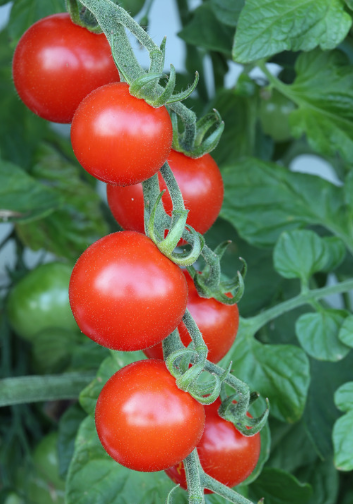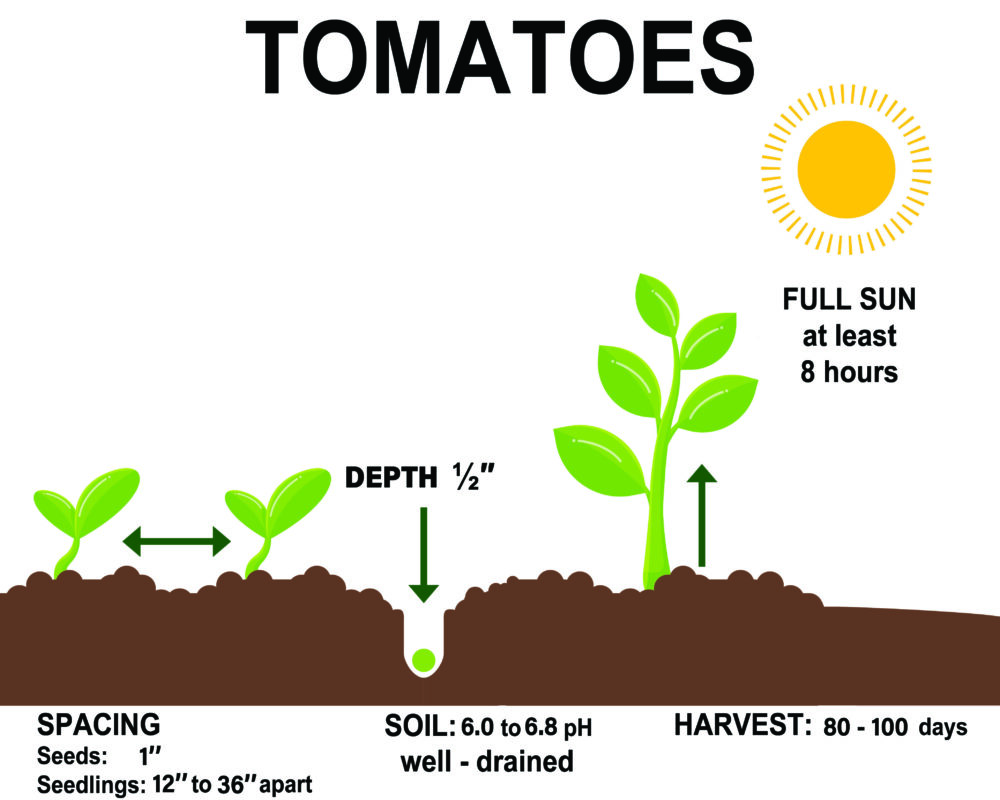If you’ve ever popped a cherry tomato in your mouth right off the vine while it’s still warm from the sun, you know why these flavorful, bitesize delights are one of the most popular garden crops. Cherry tomatoes (Solanum lycopersicum var. cerasiforme) are fairly quick and easy to grow even if you are new to gardening. They need fewer days to mature than regular tomatoes. This is a big advantage if you live in a cold climate where the growing season is short or if the temperatures in your zone heat up too fast for the fruit to set during the summer.

| Common Name | Cherry tomato |
| Botanical Name | Solanum lycopersicum var. cerasiforme |
| Family | Solanaceae |
| Plant Type | Annual, fruit |
| Size | 4–8 ft. tall, 1–3 ft. wide |
| Sun Exposure | Full sun |
| Soil Type | Loamy, well-drained |
| Soil pH | Acidic (6.0 to 6.8) |
| Bloom Time | Summer |
| Hardiness Zones | 2–11 (USDA) |
| Native Area | South America |

When to Plant?
This will be determined by your planting zone. There is a final frost date for each area. As a result, you can plan your gardening activities around this date. Check our Frost Dates Across North America: First & Last Frost Dates Chart. However, the date will not be the same for every plant.
How to Plant
Large cherry tomatoes plants prefer well-drained, fertile soil, high in organic matter. Fertile clays and loams produce the highest yields, but lighter soils that drain and warm quickly can produce earlier harvests. It can tolerate slightly acidic soils, and is most productive with pH 6.0 to 6.8.
Large cherry tomatoes is a heavy feeder and should be fertilized with an organic blend rich in phosphorus and potassium, and containing moderate nitrogen. Large cherry tomatoes need at least 8 hours of direct sun daily, and will develop faster with increased exposure. If possible, grow on a slight slope with southern or southeastern exposure. Large cherry tomatoes are native to tropical regions, and have the greatest light needs of any standard garden vegetable.

Staked and pruned plants can grow to well over 6 feet tall in favorable growing seasons, can be trained to narrow spreads. If space is limiting, use smaller determinate varieties. Large cherry tomatoes are very labor-intensive if you stake, prune or use plastic mulch and row covers. Once the last frost has passed and temperatures do not drop below approximately 50 °F at night, you can begin to consider transplanting. Don’t rush to transplant. Cold soil and air temperatures can stress plants. Wait at least a week or two after the last frost. When considering candidates for transplanting, look for sturdy, short, dark green plants. Avoid plants that are tall, leggy, or yellowish, or have started flowering. Transplants that are too mature often stall after transplanting while younger, smaller plants pass them by, producing earlier and more fruit.
Unlike most plants, large cherry tomatoes do better if planted deeper than they were grown in containers. Set them in the ground so that the soil level is just below the lowest leaves. Roots will form along the buried stem, establishing a stronger root system. To reduce root disease risk, don’t plant on soils that have recently grown large cherry tomatoes, potatoes, peppers or eggplant for at least two years.
How to Cultivate
Mulch plants after the soil has warmed up to maintain soil moisture and suppress weeds. A reflective mulch, such as red plastic that will reflect light, can be help to promote more complete development if light conditions are not ideal. Large cherry tomatoes need a consistent supply of moisture. If it rains less than 1 inch per week, water to make up the difference.
Many factors (in addition to your choice of variety) affect total yield, first harvest and fruit quality. Raised beds, black plastic mulch and providing consistent moisture by watering or through drip irrigation are good ways to improve all three.
How you provide support to plants can also affect performance. Determinate varieties do not need staking. But staking and pruning indeterminate varieties can hasten first harvest by a week or more, improve fruit quality, keep fruit cleaner, and make harvest easier. Staking and pruning usually reduces total yield, but fruits will tend to be larger. Staked and pruned plants are also more susceptible to blossom end rot and sun scald. Allowing indeterminate varieties to sprawl reduces labor, but takes up more space and plants are more prone to disease.
How to Harvest
Fruit that is fully ripened on the vine has a much fuller flavor than fruits that are picked early and then allowed to ripen. Many cherry tomatoes, however, have a tendency to crack if they stay on the plant, so they should be picked at the peak of redness, or even a tad before.
Watch the bottoms carefully; that’s where large cherry tomatoes start to ripen. Some varieties, primarily large heirloom types, ripen before they reach full color. Pick large cherry tomatoes when the skin still looks smooth and waxy, even if the top hasn’t turned its mature color (whether red, purple, pink or golden yellow).
Cut off the top of the plant, or remove all new flower clusters, about a month before the first expected frost. That way, you’ll direct the plant’s energy into ripening existing large cherry tomatoes, rather than producing new ones that won’t have time to mature.
When daytime fall temperatures are consistently below 60 °F fruit will no longer ripen on the vine, so it is time to bring all mature green fruits indoors, either on the vine or off.
Hydroponics
Germination: Start by germinating the Cherry tomato seeds. This can be done in a small container or tray with a moist growing medium such as peat moss, perlite, or vermiculite. Keep the temperature between 20-30°C (68-86°F) and provide adequate moisture for the seeds to sprout. Once the seedlings have emerged, transplant them into net pots filled with hydroponic growing medium.
pH range: The ideal pH range for hydroponic Cherry tomatoes is between 5.5-6.5. Keep track of the pH levels regularly using a pH meter and adjust them as necessary using pH up or pH down solutions.
EC: The optimal electrical conductivity (EC) for hydroponic Cherry tomatoes is between 2.0-3.0 mS/cm. This measures the nutrient concentration in the hydroponic solution. Use an EC meter to monitor the EC level and adjust it by adding or diluting nutrient solution.
PPM: The target range for parts per million (PPM) will vary depending on the specific nutrient solution you use, but generally, a range of 800-1500 PPM is appropriate for hydroponic Cherry tomatoes. Again, use a PPM meter to measure the nutrient concentration and adjust it as needed.
Humidity: Tomatoes prefer a relative humidity level of around 70-80%. Keep a humidifier nearby or use a wet towel to help maintain humidity levels.
Light hours: Cherry tomatoes require at least 12-14 hours of light per day. Use grow lights or natural sunlight to provide enough light for the plants to thrive.
Temperature air: The ideal air temperature for hydroponic Cherry tomatoes is around 21-26°C (70-80°F). Provide adequate ventilation to prevent excess heat buildup.
Temperature water: The hydroponic nutrient solution should be maintained between 18-24°C (65-75°F). Use a water heater or chiller to keep the temperature within this range.
With these guidelines, you should be able to grow healthy plants hydroponically. Good luck, and happy growing!



